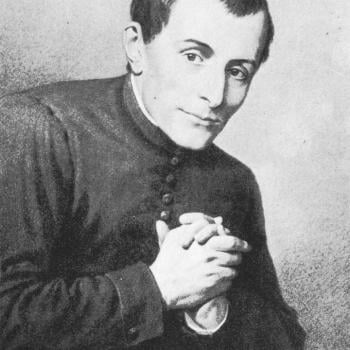 After moving away from a fundamentalist background to the Episcopal Church Robert E. Webber spent many years of his life helping evangelicals become more deeply rooted in the historical faith they are a part of. He is known to many today through his “Ancient Future” series of book, which have helped provide a context of historical Christian worship and formation for the evangelicals of today. I recently read his book Ancient Future Evangelism (Baker Books, 2003). In it he posits that conversion is a process over time that results in spiritual maturity, and has historically been done in a fourfold process which is modified to complement eras and cultures but always includes evangelism, discipleship, spiritual formation, and vocation.
After moving away from a fundamentalist background to the Episcopal Church Robert E. Webber spent many years of his life helping evangelicals become more deeply rooted in the historical faith they are a part of. He is known to many today through his “Ancient Future” series of book, which have helped provide a context of historical Christian worship and formation for the evangelicals of today. I recently read his book Ancient Future Evangelism (Baker Books, 2003). In it he posits that conversion is a process over time that results in spiritual maturity, and has historically been done in a fourfold process which is modified to complement eras and cultures but always includes evangelism, discipleship, spiritual formation, and vocation.
Ancient Future Evangelism reflects a good deal of personal reflection, and scholarship that I both admire and appreciate. Webber is able to present the Gospel story as well as the story of the church in a concise and easily accessible way that is inspiring to the reader and prophetic to the church. This does come at the cost of an oversimplification of the discipleship paradigms of the past, and a tendency to romanticize the early church while demonizing the conversion of Constantine. By fitting all christian history into 20 pages of so he does make some fairly broad generalizations.
This book’s real brilliance is not in it’s role as a historical review but in the tools that are given to translate historical Christian discipleship into an understanding of the process of Christian formation that is both contemporary and culturally relevant. In it we are given a compelling narrative of the role of the Church in fostering disciples with a mature spiritual life, and some basic tools to help develop rituals and practices to engage in the formative process with intentionality (make sure you check out the appendixes they include some great stuff!) While reading I found my mind wandering to applications of the text very naturally. This book inspires creativity in discipleship by casting a trajectory within conversion.
No matter what capacity you might be serving in ministry, and no matter how well your church is doing, I recommend you read this book. If nothing else I guarantee you it will inspire hope in you, and hope is one of the cardinal virtues we could all use more of.
Summery of the Book: You can clearly see his main idea develop over the 9 chapters that make up the book. The first chapter first establishes a need for this process, and then explores the historical trends and how disciples have been made throughout history.Chapter 2 gives a close look to the early church and the how it implemented the process. With this Webber begins to establish the tools to translate formation to our own communities. Chapter 3 dives right into our western post-modern context and he begins to flesh out what stage one, evangelism, looks like. Chapter four proceeds to stage two, discipleship. In this Webber strongly emphases having a lifestyle of worship, which is lived in response to the activity of God. Chapter five focuses on the spiritual formation stage. Webber predicates that this is done through teaching around the practices, rituals, and prayers of the church. Chapter 6 discuses the final stage, vocation. For Webber the center of vocation is the call of God. The church is called, but we too are called within the church, to be servants in our communities. When we take communion we should remember that God abides in us and we in him. He is our food in our journey of service. Chapter 7 begins the second part of the book in which is offered as an examination of the convictions that underlie this process of conversion. This chapter focuses on culture. Our culture is strikingly similar to the culture that the early church encountered. How we interact and transform it is filled with a great deal of tension. Christians must stand against some aspects of culture, but still be able to identify with it. Chapter 8 tells the story of God’s mission in the world. It looks at how the early church understood the Gospel and calls the church today to plant the story in our own settings. Chapter 9 is a call for the church to live under the rule of Jesus and not in service of the political authorities of the world. The life of the church tells a story about it’s mission,and it’s king. He encourages christian communities to actively engage in the story of God’s activity in the world today.
 After moving away from a fundamentalist background to the Episcopal Church Robert E. Webber spent many years of his life helping evangelicals become more deeply rooted in the historical faith they are a part of. He is known to many today through his “Ancient Future” series of book, which have helped provide a context of historical Christian worship and formation for the evangelicals of today. I recently read his book Ancient Future Evangelism (Baker Books, 2003). In it he posits that conversion is a process over time that results in spiritual maturity, and has historically been done in a fourfold process which is modified to complement eras and cultures but always includes evangelism, discipleship, spiritual formation, and vocation.
After moving away from a fundamentalist background to the Episcopal Church Robert E. Webber spent many years of his life helping evangelicals become more deeply rooted in the historical faith they are a part of. He is known to many today through his “Ancient Future” series of book, which have helped provide a context of historical Christian worship and formation for the evangelicals of today. I recently read his book Ancient Future Evangelism (Baker Books, 2003). In it he posits that conversion is a process over time that results in spiritual maturity, and has historically been done in a fourfold process which is modified to complement eras and cultures but always includes evangelism, discipleship, spiritual formation, and vocation.











